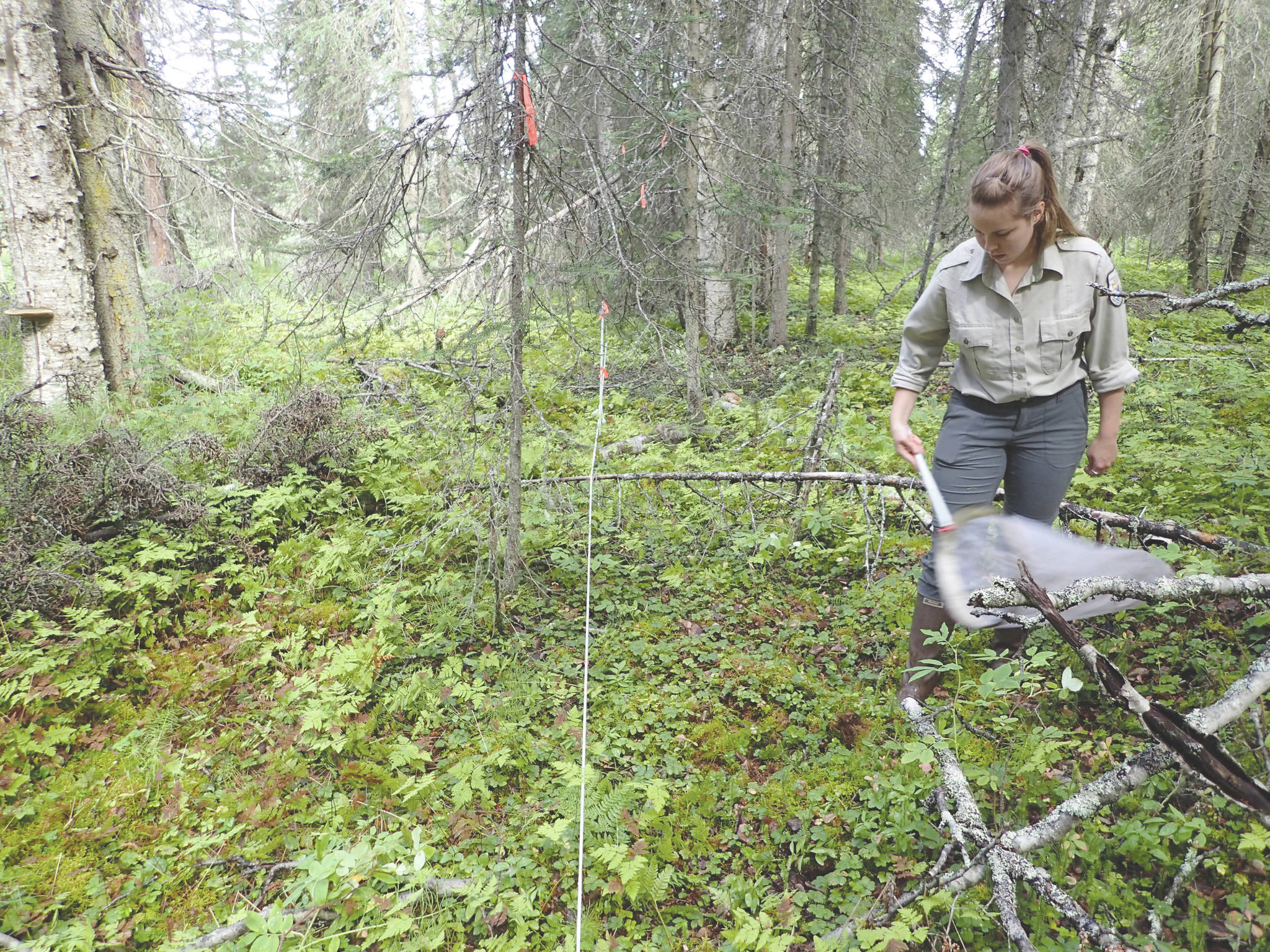I like low key, low tech, cheap science. That is part of why I became an entomologist. I love that I can walk out the back door, peek under some bark, and perhaps find an insect that I have never seen before.
When we decided to design a study to test some new survey methods basically in the backyard of the Kenai National Wildlife Refuge headquarters building on Ski Hill Road, I was excited. We would spend time walking through the woods to a grid of 40 plots within a 3.5 square mile area.
At each 1,000 square foot plot we listened for birds, documented plants, collected lichens and mosses, and swept the vegetation for insects. We did most of this work quite conventionally, with a reliance on experts to identify birds, plants and lichens. We tried out new metabarcoding methods for identifying insects.
I know I claimed to prefer low tech methods, but identifying insects using a microscope is like scooping snow with a shovel. A shovel may be great for clearing snow from a footpath, but when the white stuff piles up on a quarter mile long driveway, it is time to call a friend with a plow truck.
Similarly, pinning insects and examining them under a microscope works for identifying a small number of insects, but when there are thousands of specimens, a more powerful tool might fit the job better.
We shipped vials full of insects from each plot to a lab in Texas for metabarcoding. The mix of insects from each sample was ground up into a slurry, DNA was extracted, large numbers of copies were made of a particular short gene fragment (a “DNA barcode”), and the sequences of these DNA fragments were read, yielding over 10,000 reads per sample.
I took these reads, which are simple text files, and ran them through an analysis that determined what species the reads had come from by comparing them to a library of sequences from already identified specimens.
Our combination of conventional and metabarcoding methods worked well for quickly documenting existing communities. Altogether, we found a total of 984 species of living things from the 40 plots. Remarkably, 101 of the insect species and one spider had not been previously documented from Alaska.
We think that one reason we found so many new records was that metabarcoding methods were able to identify minute insects and even fragments of insects that are usually overlooked or discarded.
Based on the rates at which we encountered additional species, we think that we observed only about half of the insect species that were out there to be collected from the vegetation.
We counted 633 species of arthropods, but we estimate that there may be around 1,300 species of insects just in this 3.5 square mile area. This estimate excludes soil insects, aquatic insects and any others that would not be found by sweeping vegetation. Many more species remain to be discovered in our backyard!
A few of the statistics on birds were notable. We documented red-breasted nuthatches and golden-crowned kinglets at 10% and 15% of the plots, respectively. Both of these species were rarely seen on the western Kenai in the 1960s, but they have since become common. Populations of olive-sided flycatchers have been declining for some time, but we still detected them at a quarter of our plots.
We also learned that the woods and wetlands of this area are mostly free of weeds. We found zero non-native plants even though some of the plots were near roads and trails, where we know that weeds are plentiful. This means that non-native weeds have mostly failed to invade our undisturbed woods and wetlands.
The report card is not quite as good for invertebrates. We found three non-native invertebrate species: the field slug, the octagonal-tail worm (an earthworm) and the late birch leaf edgeminer (a kind of sawfly). The slug had apparently not gotten far from roads, but the earthworm and sawfly are now widespread.
Thankfully, these particular species should not change things very much. We now have communities composed of a blend of mostly native and a few recently arrived exotic species, but these modified communities should still function much as they have in the past.
The most valuable part of this project has been the testing of metabarcoding methods for identifying insects. This turned out to be far more practical for routinely identifying mixed samples of insects than examining each specimen under a microscope.
We will be working on refining our use of metabarcoding for insects and also trying out these methods for other situations, from identifying soil organisms to finding out what invertebrates are eaten by fish or birds.
If you would like to read more, an article on this backyard project appeared last week in Biodiversity Data Journal, where it is freely available at https://bdj.pensoft.net/article/50124.
As for me, I intend to keep poking around outside and learning about insects the old-fashioned, low tech way even if newer DNA-based methods become standard practice.
Matt Bowser serves as Entomologist at Kenai National Wildlife Refuge. Find more Refuge Notebook articles (1999–present) at https://www.fws.gov/refuge/Kenai/community/refuge_notebook.html.
By MATT BOWSER
Kenai National Wildlife Refuge

